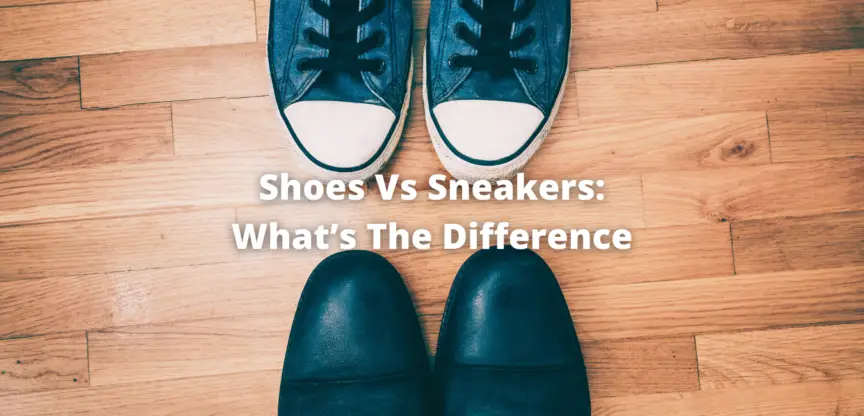ShoesandFitness.com is supported by our readers. We may earn a commission when you purchase through links on this page. Our content is checked for factual accuracy by our editorial team before being published.
The term “shoes” covers different types of footwear nowadays. However, when utilized against the term “sneakers”, shoes consist of tennis shoes or canvas shoes. So there are clearly differences when it comes to shoes vs sneakers.
Also, people never utilize the term “shoes” for sneakers. Why? What’s the key difference between shoes and sneakers? Well, for starters, they’re not designed in the same way.
They’re made with the same purpose which is protecting your feet. However, they’re still very different. That being said, let’s learn more about their key differences.
What Are Shoes?
People consider shoes a great accessory that keeps their feet warm, dry, and comfortable. They’re made of both synthetic fabric such as polyurethane and nylon and leather.
And they’re utilized on top and bottom of both sports and athletic shoes, in general. Most people prefer these shoes because they’re easy to clean and maintain with a damp piece of cloth.
Their sole is made of polyurethane that’s very flexible and acts as a shock absorbent. If you run or enjoy walks on hard terrains, opt for shoes with hard outsoles as they resist wear and tear.
They also provide extra durability. Soft soles, on the other hand, make a great choice for daily routine as they’re lightweight and provide great comfort when walking around.
What Are Sneakers?
The term “sneakers” covers sports shoes nowadays. It’s very common among people who wear all sorts of shoes with rubber soles. However, their rubber soles have nothing to do with their name.
Actually, the actual reason why sports shoes got their name “sneakers” in the first place was that they made little noise when walking due to their rubber soles, thus you could easily sneak up to people while wearing these shoes, and hence the name. There’s a wide variety of sneakers available today.
You can easily find sneakers for running, sneakers for jogging, etc. People in North America use the term “sneakers” whereas people in England and Australia prefer terms like “trainers” and “joggers”.
Shoes Vs Sneakers: 10 Key Differences
All shoes serve the same purpose which is protecting your feet. However, nowadays, there’s a variety of shoes including tennis shoes, canvas shoes, sneakers, etc. Therefore, when you compare standard shoes and sneakers, there’s a list of key differences such as the following.
Material
All shoes have one thing in common which is protection. They’re all supposed to protect your feet while ensuring comfort and warmth with materials like polyurethane and nylon. These synthetic materials can be found on the top and bottom of most shoes because they’re low-maintenance.
However, what’s different about standard shoes and sneakers is the sole. Sneakers have a special rubber sole that’s long-lasting, comfortable, and doesn’t release noise. They’re also made of synthetic materials but provide a soft sole that helps you “sneak” into a place without getting noticed.
Comfort
Shoes provide great comfort for different activities including running if you select the right pair of shoes. Otherwise, you will likely experience pain and discomfort during movements.
Sneakers, on the other hand, ensure great comfort. And you never have to stress about sneakers feeling heavy so you can wear your sneakers on a daily basis for walking, working, etc.
Purpose
Some people wear shoes for comfort and stability while others prefer stylish and somewhat comfortable shoes. This explains why there’s a wide selection of types and designs of shoes out there.
Shoes usually have durable construction and serve different purposes such as walking, running, training, and so on. And each category provides the proper amount of traction, stability, and comfort.
For instance, training shoes have extra rubber padding that supports your movements. Sneakers, on the other hand, have exceptional rubber soles. They’re also available in a broad range of designs.
However, they’re not all suitable for sports-related activities such as running, training, etc. They’re plain athletic shoes with a synthetic material or canvas top and rubber soles but don’t have the technicality of sports like shock absorption and lateral support. However, they’re comfortable and flexible.
Cushioning
If you don’t consider cushioning when purchasing shoes or sneakers, you’re welcoming discomfort along with pain, injuries, and conditions like plantar fasciitis. Whether you’re interested in purchasing sneakers or shoes, cushioning is important. Unfortunately, most sneakers don’t feature a lot of cushioning.
With shoes, you don’t need to worry about this aspect because they’re usually made of comfortable and dense materials. Meaning, they protect your feet against any discomfort, various injuries, and pain.
Motion control
Another key difference between sneakers and shoes is motion control (the amount of control the shoes offer at the time of wear). Motion control plays a key part in activities like running.
However, for general use, this feature isn’t crucial. Generally, when compared to tennis or canvas shoes, sneakers provide better motion control. However, it all depends on the manufacturer.
Sneakers include outsoles made of top-notch rubber. The bottom consists of special ridges for additional control. Tennis and canvas shoes also include rubber outsoles but also weak ridges.
Stability
The gripping capacity of the shoe matters as well. This includes how the uppers provide a stable fit and feel. Sneakers offer excellent stability because of the laces installed in the upper part.
No matter the design, every pair of sneakers has laces. Shoes, on the other hand, may or may not deliver laces. Some shoes have a Velcro strap. Therefore, stability depends on the manufacturer.
Other alternatives can also ensure a stable fit but laces deliver the greatest stability. Generally, sneakers provide better stability than shoes, so keep that in mind when shopping for footwear.
Durability
Shoes provide greater durability than sneakers because sneakers have very light rubber soles. Therefore, the sole isn’t durable enough. Meaning, sneakers can’t handle a lot of pressure.
Additionally, sharp things can pierce rubber soles very easily, so if you can’t walk on rocky terrain with a pair of sneakers. Shoes, on the other hand, consist of polyurethane which is a sturdy, flexible, and strong material. They can handle high-pressure impact and sharp things can’t easily pierce shoes.
Meaning, you don’t have to worry about anything when walking on rocky or bushy terrain with shoes on as they provide durable and tough outsoles and can withstand almost any terrain.
Heel height
Running shoes have a built-up heel to ensure stability for runners. People debate over which part of the foot should land on the ground first to prevent injuries and run quicker.
Usually, their heel comes down with their body weight with a great amount of strength so that it propels them up for the following step. And the process repeats itself for as long as they run.
Therefore, they need shoes with good heels to help them with the upward movement for the next step. Walkers, on the other hand, don’t need good heels, so they can easily wear flat shoes.
They land on the ground with their entire foot at the same time so they don’t need a special heel design. Therefore, keep these things in mind when shopping for sneakers or shoes.
The flare of the heel on the shoe
Certain running shoes have flared up heels to provide additional comfort to runners whose feet land on the ground with their forefoot. The flare is an additional safety measure applied by shoe manufacturers to provide extra maximum comfort and prevent any injuries to their feet.
Regular walking shoes don’t have this type of heel because people land on the ground first with their heels. And if the heel is flared up, it can cause different injuries as the foot will move forward during the step. Therefore, undercut heels make a perfect choice for walking shoes.
Flexibility
Last but certainly not least, I want to talk about flexibility. All gym shoes and workout shoes provide a lot of flexibility and comfort because exercises can easily lead to different foot injuries.
And wearing the wrong shoes is one of the biggest reasons behind fitness injuries. Running shoes deliver great flexibility as well. They’re designed to move freely from the arch to the midfoot.
Walking shoes, on the other hand, aren’t as flexible as running shoes. They bend at the arch because the toes should move as they provide support for the rest of the foot for the following step.
Avoid shoes that don’t bend at all. They obviously lack flexibility which can cause a strain on the foot and can cause a bad injury. Opt for shoes or sneakers that provide some type of flexibility.
Summary – Shoes Vs Sneakers
Although sneakers and shoes serve the same purpose, they’re different in many ways. Therefore, when shopping for footwear, note the differences mentioned in today’s article.
If you’re looking for something strong that can handle a lot of pressure, then look no further than shoes. However, if you need something for daily wear, then sneakers make a perfect choice for you.
When making your decision, consider your budget, needs, and style as well.
Take a Look at These Articles
What Does PS Mean in Shoes: Understanding the Terminology?
Best Walking Shoes for Flat Feet and Overpronation
Best Shoes for Music Festivals

